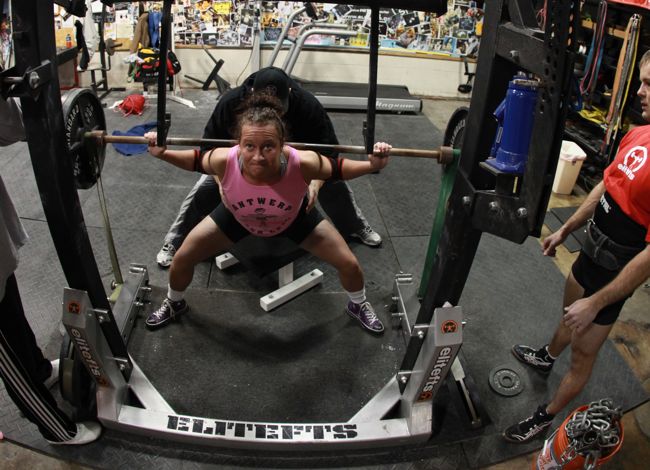
Squat depth has been a matter of controversy in powerlifting since the 1970s and continues to be so. In today's era, the usual focus is on squats passed in multi-ply competitions that seem insufficiently deep.
I would like to discuss an aspect of the depth debate that is less focused upon—the frequent requirement of excessive depth in the International Powerlifting Federation (IPF) and its American affiliate, USA Powerlifting (USAPL). Legal squat depth in the IPF is defined as follows: "Upon receiving the chief referee’s signal, the lifter must bend the knees and lower the body until the top surface of the legs at the hip joint is lower than the top of the knees." (The World Powerlifting Congress rulebook likewise states, "Upon receiving the head referee’s signal, the lifter must bend the knees and lower the body until the top surface of the legs at the hip joint are lower than the top of knees.")
With this standard in mind, I will begin with three squats from three continents that were turned down on depth:
It isn't a petty complaint but plain reality to note that these squats were sufficiently deep. There have been numerous other incidents like this through the present, which space considerations do not permit me to post. As some more recent examples, see the first squat and the third squat (and another third attempt from this year). As a notable historical example, see Ed Coan's third squat at the IPF Worlds in 1996.
There are two problems with requiring a standard of depth beyond what the rulebook describes. The first problem is fairness and respect. Lifters have trained for months and often traveled significant distance at considerable expense to compete at a meet. Fair judging is the most fundamental respect they deserve. When referees red light squats that aren't even borderline good but clearly deep, an obnoxious theft has occurred. (Speaking of borderline situations, IPF policy is that "All doubt must be made in favor of the lifter." Policy and practice are often two different things though.)
The second problem with requiring excessive depth is lifter safety. Jake Impastato, who competed at the 2010 USAPL Raw Challenge at the Arnold Classic, remarked of his meet experience in relation to powerlifting legend Mike Bridges bombing out on squats (view his first and third attempts), "When I arrived that morning, the rumors going around the Grand Ballroom were that your squats had to be very deep. There happened to be quite a few injuries that were probably due to lifters really trying to go extra deep on their squats. I actually got a light quad strain that forced me to pass on my third squat."
Likewise, Becky Rich, who holds the world record raw total without wraps in the 123-lb weight class, comments about 2008 USAPL Raw Nationals: "It was the inaugural USAPL Raw Nationals, and it seemed like the judges had something to prove. A large number of first day lifters ended up bombing and not necessarily because they deserved it." Similar accounts followed 2006 USAPL Masters Nationals, as reported on the website PowerliftingWatch on May 8, 2006 and May 21, 2006.
A final example—a top USAPL lifter's opening squat at the IPF Worlds a few years ago was turned down on depth, despite being clearly good. The lifter repeated the weight and "went extra deep," the coach told me. This resulted in a back injury, a failed third attempt, and diminished deadlift performance.
Such injuries are to be expected with excessive depth. Mark Rippetoe, coauthor of Starting Strength: Basic Barbell Training and competitive powerlifter from 1978 to 1988, has noted in the context of "ass to grass" squats, "Squat depth is critically important but so is correct form. ATG-level depth most usually requires that the lumbar muscles relax the lordosis and that the hamstrings relax before extreme depth can be reached. It doesn't sound like a good idea to me that anything be relaxed in a deep squat, [because] doing this kills your good controlled rebound out of the bottom and risks your intervertebral discs."
And that much less of a good idea with a maximal weight on one's back.
If unfair judging that jeopardizes lifter safety is probable in certain meets, lifters deserve to be aware of this before investing money and confidence in the competition. If a lifter is OK with likely rejection of good squats or jeopardizing their spinal and orthopedic health to secure lifts, that's their freedom of choice. But people should know what they're getting into.
"Prudence and caution please," wrote a senior USAPL official in a recent USAPL newsletter ridiculing federations that he called "just the new flavor of the month and are soaring in numerous liabilities." The assertion of liabilities is particularly brazen given the liabilities that USAPL practices with its unsafe depth requirements. Prudence and caution? Both are in order toward an organization that displays habitual recklessness and unfairness. (As another example of glaring liability, at least one of the platforms at the 2010 USAPL American Open was hazardous. See the deadlifts and lifter's comments in this video.)
I competed at the state, regional, and national level in the USAPL from 2007 to 2009. I found squat judging to be fair in Florida, and other lifters competed in the USAPL based on my recommendation. It is now 2011, and I can't ignore what I have learned between 2009 and now. As the saying goes, "When the facts change, my opinion changes."









I see, way too often, people loading up weights to a barely full depth then increasing weights and only achieving a 3/4 squat. If those same lifters went to an IPF meet, and tried the same weights for the full ROM - i wouldn't be surprised to see injuries.